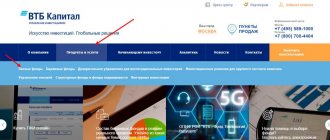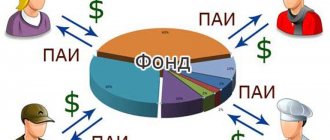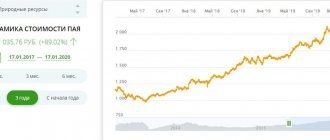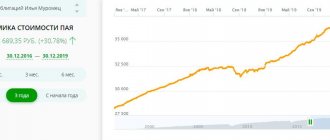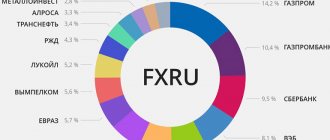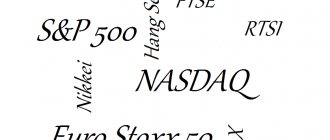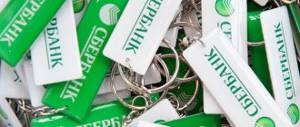It is important to know that when joining a mutual fund, an investor does not purchase a certain number of shares, but invests in the fund any amount above the minimum threshold. As a rule, for private investors this threshold does not exceed several thousand rubles.
Then the registrar credits the shareholder’s account with a certain number of shares. It is calculated by dividing the amount contributed by the investor by the estimated value of one share on the day the information is added to the register. Please note that in this case the amount is reduced by the amount of the surcharge. The number of shares owned by one investor may be fractional.
See also: Rating of mutual funds in Russia
Dynamics of share value and NAV
To make the operating principle of mutual funds clearer, I will consider an example: you buy a share (share in the Balanced investment fund) for 1000 rubles. If the value of the deposit increases, you will make a profit when you sell the share.
And vice versa: a fall in the price of a share will lead to losses. The value of a share is directly related to the net asset value. NAV is calculated as the difference between a company's assets and the amount of its liabilities.
The dynamics of the share price are shown below.
The chart shows a smooth growth without sharp drawdowns, which indicates a moderate risk of the mutual fund.
The positive dynamics are due to the increase in NAV from RUB 1.4 billion. up to 10.7 billion rubles. in 3 years. To evaluate the management efficiency of the Balanced mutual fund, a benchmark is used. For this mutual fund, Sberbank uses a basket of indices (50% IMOEX, 50% IFX-CBonds).
The graph shows that the management team copes with its task 100%: the dynamics of the value of the share and the index are almost identical.
Foreign IT shares. "RAIFFEISEN - INFORMATION TECHNOLOGIES"
Raiffeisen Capital in Russia was founded in 2003 and is a 100% subsidiary. When choosing assets, the management company relies on fundamental analysis and adheres to long-term investments. Portfolios are compiled using a bottom-up method, that is, from an assessment of the business of an individual company.
When choosing foreign instruments, the management company uses the experience of colleagues from the international Raiffeisen group.
Mutual Fund "Raiffeisen - Information Technologies" uses the strategy of investing in global shares of high-tech corporations. The portfolio contains predominantly American companies, which have shown the highest growth rates of financial indicators in recent years. There are also companies from China, India and Taiwan.
Since the fund’s currency is ruble, if the national currency is devalued, the fund can receive additional profitability.
Fund structure by industry:
Commissions:
- 3.9% Management remuneration
- 0.7% Depository
- 0.6% other expenses
Asset structure by company (03/31/2021):
The management company relies on leading American IT companies. The revenue growth rate of these companies is about 20-25% per year, and a low debt load with a large reserve of cash on the balance sheet allows companies to invest in new promising projects.
Below is a comparative table of funds with similar assets.
| Name of mutual fund | NAV, RUB million | Number of years of the formed fund | Minimum contribution, rub | Infrastructure costs (total), % | Profitability of mutual funds for 5 years, % | NAV growth over 5 years, % |
| RAIFFEISEN - IT | 8 763 | 14 | 1 000 | 5,2% | 213% | 2 888% |
| Otkritie - leaders of innovation | 2 464 | 8 | 1 000 | 5,5% | 179% | 7 536% |
| Promsvyazbank - IT | 1 866 | 17 | 1 000 | 4,5% | 179,85% | 7 734% |
| Alpha capital - Technologies | 13 437 | 14,5 | 100 | 4% | 169,75% | 1 786% |
| Sber - Global Internet | 11 679 | 10,5 | 1 000 | 3,85% | 125% | 380% |
| Nasdaq-100 Index | — | — | — | — | 217% | — |
Companies invest in the same issuers, and the main difference is the size of the stake in a particular stock. For example, Mutual Fund - Sberbank Global Internet holds 12% in an ETF that manages IT companies in China; others do not have this fund. Such small differences can affect the returns of the funds, but in general they are the same in structure.
If we compare the returns of funds with the global Nasdaq-100 index, in which there are mainly technology-based companies, they are closest to the index values. It is worth considering that funds have management fees, which are directly proportional to the overall return.
Advantages and disadvantages
One of the positive aspects of the Balanced Mutual Fund is the simplicity of investing: just go to your Sberbank personal account, click the “Buy online” button, and you become the owner of a share. Such investments do not require specific skills and knowledge, as with independent investing in shares.
For 2021, the mutual fund showed a return of 21.41%. Taking into account the commission (up to 6.4%), the investor receives 25% less profit indicated on the chart. Such investments are not practical for long periods.
But a mutual fund cannot guarantee future profits based on past results. Investing in a mutual fund involves risk. You are required to pay a commission even if you make a loss, which can increase your losses even further.
How to invest
To purchase a share you need:
- go to the official website of Sberbank Asset Management;
- open the “Mutual Funds” section. In the “Open-end mixed investment fund” category, click on “Balanced”;
- in the tab that opens, click on “Buy online”;
- indicate the investment amount, personal data, confirm payment.
Within a week after payment, you become a shareholder of the Sberbank Balanced mutual investment fund.
Feedback from investors
In general, the conditions for investing in the Balanced mutual fund are acceptable. To avoid losing your savings, you must carefully read the terms of the contract. One of the investors in Sberbank mutual funds writes about this.
Another investor writes that the first investment was successfully withdrawn, but the balance of money in the account was withdrawn with a strong delay: it would not be possible to withdraw money on time.
On my own behalf, I would add that before investing money, you must consult with the manager of the investment fund, carefully study the documentation, then such situations will not happen.
Taxation of mutual funds
As a matter of fact, I have already said the most important thing about mutual fund taxes. Funds do not pay income tax of 20%, as well as on coupon income on bonds. Tax on dividends is formally charged (accounted for as receivables), but in fact is paid on the date of redemption of the share - i.e. During the entire operation of the fund, the money works for the investor.
This makes mutual funds very beneficial for tax optimization, which is why rich people are very fond of “packing” their assets into closed mutual funds for this very purpose.
When redeeming a share, an individual will need to pay personal income tax at a rate of 13%. For example, you bought shares in the amount of 150,000 rubles, and sold them for 170,000. On 20,000 rubles, you need to pay 13% - 2,600 rubles.
If you own mutual fund shares for 3 years, you can apply a tax deduction in the amount of 3 million rubles for each year of ownership. That is, after 3 years the deduction is immediately equal to 9 million, after 4 – already 12 million, after 5 – 15, etc.
For example, if you invest 25 million rubles in a mutual fund and earn 30 million, then in order not to pay personal income tax, you need to own the shares for at least 10 years.
Newbie
A novice investor should familiarize himself with the intricacies of investing so as not to lose his savings. However, there is no better way to learn something than to try it. Now I will tell you what a beginner should pay attention to.
What is a mutual fund and why is it needed?
You have free money that you want to invest. The management company (MC) invests your funds in assets, for which it takes a certain percentage. An investment mutual fund may make a profit (if the sale price of the purchased unit is higher than the purchase price) or a loss (the purchase price is higher than the sale price).
Advantages and disadvantages of mutual funds
The need for knowledge and skills makes investing out of reach for most people. The use of trust management allows beginning investors to increase their savings.
Real inflation is higher than the official one, so a bank deposit does not save money from depreciation. The high income of a “Balanced” mutual fund allows you not only to preserve, but also to increase your savings.
The share has high liquidity: you can get money back almost immediately. Early withdrawal is possible.
The negative side of mutual funds is risk. Even conservative management strategies can bring losses to the investor. To generate above-average returns, a mutual fund must return at least 20% annually to cover fees.
Risks
You need to approach investing in Sberbank mutual funds wisely. You should not invest borrowed funds in the Balanced investment fund, mortgage real estate or take out loans, as there is a risk of losses.
What affects the risk level of a mutual fund
Profit in the past does not guarantee that the Balanced Mutual Fund will receive income in the future. To insure your investment, you need to consider the following factors:
- the cost of a unit of a “Balanced” Mutual Fund is directly dependent on the NAV. It is necessary to take into account the state of the economy and the growth potential of the industry;
- The age of the management company is an indicator of the reliability of the organization. There are young, highly profitable projects that promise a 100% increase in profit per year. After receiving the money, the project is closed and the money is not returned. The Sberbank team has many years of experience and is recognized as the best in the field of investment capital management;
- The main factor influencing the degree of risk is the aggressiveness of the strategy. The higher it is, the more profitable the investment instrument, but with the profitability the risk also increases. Conservative strategies allow you to avoid severe drawdowns, but the profit percentage is much lower.
What can be done to reduce risks
Diversify. Dividing investments into several assets (for example, using the “Balanced” fund and the Ilya Muromets mutual fund) reduces risk and minimizes potential losses: a loss-making investment is offset by profits from another.
Mutual Fund Infrastructure
A mutual fund does not exist on its own. The funds, as we already know, are managed by a management company. She is helped in this fascinating task by:
- registrar - an organization that keeps records of shareholders and issues new shares to new participants on behalf of the fund;
- specialized depository - an organization that directly stores the funds of the fund and ensures transactions with the property of the fund;
- auditor – controls the activities of the fund, checks the legality of transactions and reporting.
Some mutual funds have a more complex structure. For example, the infrastructure may include a custodian bank that provides physical storage of assets (for example, gold), a market maker that ensures liquidity of fund shares (if the mutual fund is traded on an exchange), and an appraiser (for closed-end and interval mutual funds).
Russian mutual funds have one common disease: many elements of the infrastructure are affiliated with the management company. For example, the depositary of VTB mutual funds is the “VTB Specialized Depository”. The same story applies to Raiffeisenbank, Sberbank and other large management companies. Often a management company has its own “pocket” registrar, appraiser and even auditor.
In theory, this should reduce the fund's expenses, but in practice it leads to abuse. For example, you can ask the auditor to “turn a blind eye” to some flaws, and the depositary to carry out a dubious transaction.
Exchange-traded mutual funds (BPIFs) also inherited the same disease from ordinary mutual funds. Pay attention to the affiliation of management companies and infrastructure.
For comparison, with an ETF, all infrastructure elements are necessarily independent both from each other and from the management company. And it doesn’t turn out to be more expensive - on the contrary, ETF commissions are an order of magnitude lower than the costs of mutual funds.

